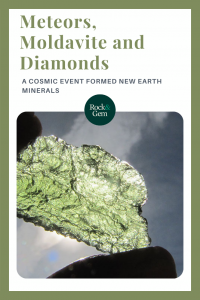
Moldavite is well known to mineral collectors, not so much for its semitransparency and bottle-green color, but for its meteoric origin.
What is Moldavite?
Moldavite is a type of tektite, a natural glass that is thought to have formed in the extreme heat and pressure of a meteoric impact. The term “moldavite” is locality-specific and refers only to tektites from the western Czech Republic and immediately adjacent areas.

Of all the various tektites, moldavite is by far the best-documented and most widely collected. It is named for the Czech town of Moldauthein, where it was first reported and studied in 1787.
Because it lacks both a crystalline structure and a definite chemical composition, moldavite is not a mineral, but a mineraloid. A mineraloid is a natural, mineral-like material.
Moldavite Facts
Moldavite has a Mohs hardness of 5.5-6.0, a specific gravity of 2.35, a vitreous luster, and a conchoidal fracture. It consists mostly of silica, along with varying amounts of water and the oxides of aluminum and iron. These small amounts of iron minerals create a characteristic bottle-green color. Moldavite is transparent to translucent with prominent, internal gas bubbles and swirl marks. Both chemically and physically, moldavite is somewhat similar to the natural volcanic glass obsidian.
Moldavite Origins
Moldavite was initially assumed to be either a form of obsidian or man-made glass. But in 1900, Austrian geologist Franz Eduard Suess observed that the unusual pitting on moldavite surfaces was similar to that found on the surfaces of meteorites. Suspecting that moldavite had solidified from a molten form and possibly had a cosmic origin, Suess coined the word “tektite,” from the Greek tektos, meaning “molten”.
Although most scientists agreed that moldavite was formed through meteoric impact, they lacked a “smoking gun” as proof. Then in 1960, a 15-mile-wide surface depression in southern Germany called the Nördlingen-Ries Crater, previously assumed to be volcanic, was determined to be of meteoric origin. Research indicated that the crater had been formed 14.4 million years ago by the impact of a mile-wide meteor traveling at about 45,000 miles per hour.
Researchers quickly correlated the site of the Nördlingen-Ries Crater with the scatter-pattern of known moldavite occurrences. This pattern begins near the crater, then trends eastward into the western part of the Czech Republic, where most moldavite occurrences have been reported.
Moldavite’s Cosmic Origins
Most researchers agree that moldavite consists of terrestrial matter that was originally high-silica sand and rock. They theorize that this material was instantly fused by the tremendous heat of the meteoric impact, then ejected into the atmosphere—possibly even into near-space—where it cooled, solidified and returned to Earth as moldavite.
Some researchers, however, suggest that moldavite may be of cosmic origin. They contend that, with proper atmospheric conditions, parts of the meteorite itself may have melted during entry, then scattered, solidified, and fallen to Earth separately from the main impact.
However, moldavite formed, its supply appears to be limited. Researchers estimate that no more than about 275 tons of moldavite ever existed. Because of dwindling recoveries, commercial moldavite collecting in the Czech Republic may end in as little as 10 or 20 years.
Moldavite and Diamonds
The meteor that created moldavite also left another surprise: diamonds. Geologists believe that a graphite deposit was also consumed during the impact. The enormous heat of the impact melted the graphite, which consists entirely of elemental carbon, while the extreme pressure enabled it to instantaneously recrystallize as diamond—as much as 80,000 tons of diamonds, all smaller than 0.2 mm. Interestingly, these diamonds ended up in sediments that later lithified into the sandstone used to construct many buildings in the nearby city of Nördlingen.
This story about what is moldavite previously appeared in Rock & Gem magazine. Click here to subscribe. Story and photos by Steve Voynick.














